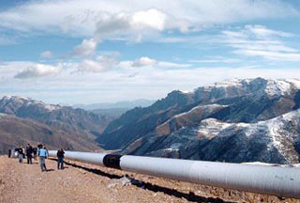'The public energy debate is ill-informed and superficial'
on
CEO GasTerra Lankhorst launches plan for Energy Academy
'The public energy debate is ill-informed and superficial'
"Public acceptance" has become a huge problem for the energy industry in Europe. Public opinion is increasingly turning against almost any kind of energy project - from CO2-storage to new networks, windmills, coal-fired power stations and nuclear power stations. According to Gertjan Lankhorst, CEO of Dutch gas trading company GasTerra and vice-President of industry association Eurogas, the level of the energy debate must be drastically improved. As a first step, he wants to see an Energy Academy set up in the Dutch gas capital Groningen.
 |
| Gertjan Lankhorst: 'The safety of CO2 storage is unquestionable. People have been terrified for no reason at all.' (photo: Roger Dohmen) |
Gertjan Lankhorst has a dream. He wants the University of Groningen, the city in the northern Netherlands where much of the Dutch gas industry is concentrated, to establish an Energy Academy. In other words, he wants the University to offer a complete bachelor and master education in “energy” – in the broadest sense of that word.
Lankhorst unfolded this vision in a speech recently at the Groningen University. He says he has already got a lot of positive response, including from the Dutch government, for this initiative, which would be fairly unique in Europe.
The idea was borne out of a concern that Lankhorst has long felt about the poor level, in his eyes, of the public energy debate. ‘Public discussions on energy’, he says, ‘tend to be ill-informed and superficial. What you hear mostly are contradictory opinions on a host of different issues. What you rarely hear is a comprehensive, balanced vision of the energy problems we are faced with.’
Lankhorst notes that the academic world is almost totally absent from the public energy debate, unlike say in debates on economics or physics. ‘There are very few authoritative intellectuals who figure prominently in discussions on energy. That’s why I believe universities need to set up interdisciplinary schools for Energy, where the subject is treated in all its dimensions – political, economic, and technical.’ Hence, the idea of the Energy Academy.
The prevalence of “populist” viewpoints in the energy debate explains why there is growing public resistance to energy projects, Lankhorst feels. ‘People hear they have to allow high-voltage cables to go through their backyard or allow underground CO2 storage underneath their houses, but they don’t really understand why, or how to weigh costs and benefits.’
Temptation
Lankhorst – who was Director-General of Energy at the Dutch Ministry of Economic Affairs before he became CEO of GasTerra – concedes that industry and government partly have themselves to blame for the public acceptance problem. ‘We failed to see the necessity of better public education. I remember that in 2003, when I worked at the Ministry, the Directorate-General of Energy was merged
| If you know that you are going to be dependent on Russia for a quarter or a third of your gas supplies for a long time to come, I would try to establish good relations with Russia |
The problem is not confined to the Netherlands. It is felt throughout Europe. In EU policy, Lankhorst – who is also vice-President of industry association Eurogas – likewise sees a lack of coherence and consistency. ‘There is a lot of knowledge in Brussels about specific topics – regulation, climate, geopolitics. But the challenge is to connect the dots. And then to carry out a consistent energy policy.’
As an example of EU inconsistency, he mentions the EU’s security of supply policy. He is surprised at the active role the European Commission has taken upon itself to secure gas supplies from the Caspian and the Middle East and thereby reduce dependence on Russia. President Barroso personally went to Azerbaijan in January where he signed a “joint declaration on the Southern Gas Corridor” with Azerbaijani President Ilham Aliyev, in an apparent effort to boost the prospects of the EU-backed Nabucco pipeline project. ‘How should I interpret this?’ Lankhorst wonders. ‘I thought the idea of the internal market is that we would have strong internationally oriented companies that can take care of our gas supplies. They have been doing so for decades, in fact.’
At the same time, he says, ‘it seems that we are saying to the Russians that we don’t want their South Stream pipeline. I don’t think this makes sense. If you know that you are going to be dependent on Russia for a quarter or a third of your gas supplies for a long time to come, I would try to establish good relations with Russia.’ Nor is he enamoured of the idea of the Caspian Development Corporation, a purchasing agency that the Commission is considering setting up to buy gas collectively from outside suppliers for the EU. ‘This will undermine the activities of companies that are active in the Caspian region.’
Greater risks
Ex-policymaker Lankhorst strongly believes that policymakers should set up a proper regulatory framework – and then let the market do the work. ‘The internal market is not completely finished yet, but
| The internal market is not completely finished yet, but it is snowballing through Europe |
In some parts of Europe, the liberalised gas market is already flourishing, Lankhorst notes. ‘The UK market is leading in this, followed by the Netherlands.’ In these markets the oil-indexed long-term contracts of the past are more and more giving way to spot trading. In the Netherlands, GasTerra has virtually no oil-indexed long-term contracts with its customers anymore, says Lankhorst. ‘They have disappeared in the last four or five years.’
Nevertheless, he is convinced that there will always be a role for long-term contracts. ‘Energy companies have to think about their long-term interests. They will be needing gas today, tomorrow and
Nor does Lankhorst believe that the link between oil and gas prices will entirely disappear. ‘Note that the companies that produce oil, like Shell and ExxonMobil, also produce more and more gas. If oil prices are higher, they will direct more of their resources to oil and less to gas. In addition, in the Middle East a lot of gas is used in the production of oil. And Shell has started up a huge gas-to-liquids operation in Qatar. These are all factors that make a continuing link between oil and gas prices likely.’
With the growing importance of spot trading, financial institutions are increasingly active in the gas market, as they have been in oil. Doesn’t this lead to greater risks? Lankhorst doubts it. ‘Companies like Deutsche Bank and Merrill Lynch are already large customers of us. They buy billions of cubic metres on the TTF and then go on to trade this gas. By doing so they enhance the liquidity of the market. And they contribute to growing convergence of gas prices on the European market. They know how arbitrage works!’
Below the radar
 |
| Gas pipe Azerbaijan - a hoped-for source of gas for the EU (photo: Press TV) |
At the same time, Lankhorst notes that in recent years mono-gas suppliers like GdF and Ruhrgas have all been integrated into diversified energy companies, which do not see themselves as “gas companies”. ‘We are the only mono-gas supplier left in Europe.’ However, with oil companies like Shell and BP now moving increasingly into the gas market, the industry has been putting more effort into “gas advocacy” lately. A campaign has been waged to position gas as the ideal “bridging” fuel in the transition to a low-carbon economy. Although this has had some success, many people in the industry are now worried that gas will come to be seen too much as a “transition” fuel, i.e. one that will be phased out in the long term.
But Lankhorst does not see the role of gas diminish in the long term, despite all the plans for “decarbonisation” by 2050. ‘Technically, decarbonisation may be possible’, says Lankhorst. ‘But I don’t believe that it makes sense in economic terms. The world will need more and more energy due to the ever faster expansion of emerging economies such as China and India. In that context, fossil fuels
| Technically, decarbonisation may be possible. But I don't think that we as a society will be prepared to bear the costs involved |
Oil Age
So what should be done according to Lankhorst to deal with the climate issue? ‘I think you should put a price on CO2 emissions. Either in the form of a carbon tax or an emission trading scheme like we have now.’
What about carbon capture and storage (CCS)? Is this an option for gas-fired power stations? ‘Well, emissions from a modern combined cycle gas turbine are roughly equal to those of a coal-fired power station with 80% CCS. Having said that, I think as gas industry we should be pro-active on this and look into the possibilities of CCS. CCS is already used in gas production – CO2 is reinjected in fields that produce gas with a high CO2-content – so it’s not a new technology.’
The future for gas would even be brighter of course if it could replace oil in the transport sector. But Lankhorst does not see this happen. ‘It is a bit of a waste to use such a high-value product as gas for a
| After the revolution in unconventional gas, there is a lot of talk now about unconventional oil. Maybe that’s where the next revolution will happen |
|
GasTerra and the future of the Dutch gas market
GasTerra is a rather peculiar animal, a product of the intricate public-private structure of the gas market that evolved in the Netherlands after the discovery of the huge Groningen field in 1960. It was formed in 2003, when monopolist Gasunie was split into an infrastructure company, owned 100% by the State, and the trading company GasTerra, half owned by Shell (25%) and ExxonMobil (25%) and half by the Dutch State. GasTerra is an active player on the free market, with a turnover of €18.4 billion last year on sales of 91.5 billion cubic metres (bcm) of gas. At the same time, it performs certain tasks set by the government. It is required, for example, to buy up gas from small fields and so offer private producers a guaranteed market for their product. This policy is meant to stimulate production from small fields, which might otherwise not be profitable to exploit. In addition, GasTerra buys and markets all the gas produced by the Nederlandse Aardolie Maatschappij (NAM), a joint venture of Shell and ExxonMobil, which exploits the Groningen field. Thus, through GasTerra, the Dutch government is able to stimulate (and regulate) Dutch gas production and maximise returns for the State. According to Lankhorst, GasTerra will continue to play its key role in the gas market for many decades to come. The Netherlands has been producing roughly 60 bcm annually for many years. The contribution of the “small fields” was some 40 bcm in 2000, and has since declined to about 30 bcm. If no measures are taken, it will decline further to some 5-10 bcm in 2025-2030. But the ambition of the government, says Lankhorst, is to keep non-Groningen production at the current level at least until 2030. Part of the new production might come from unconventional gas, in particular shale gas and coalbed methane. The Netherlands has some 476 bcm of technically recoverable unconventional gas (in addition to 1372 bcm of proven reserves and 400 bcm of technically recoverable conventional gas), according to data from EBN, the state-owned company that participates in all exploration and production activities in the Netherlands. The technique of fracking, used to produce shale gas, is in fact not new to the Netherlands. ‘We have been doing this for many decades’, says Lankhorst. ‘It was done – and still is – to enhance recovery from existing gas resources.’ In addition, the Netherlands is trying to stimulate the production of biogas (or “green gas”). Lankhorst expects that biogas will be able to contribute some 3 bcm to Dutch production in ten years or so. The CEO of GasTerra regrets that the Dutch government abruptly cancelled a plan to store CO2 underground in empty gas fields in the north of the country, citing reasons of safety. ‘This decision was made on the wrong grounds. The safety of CO2 storage is unquestionable. An image was created of huge disasters that could happen. People have been terrified for no reason at all.’ The government decision has already led to a decision by energy company Nuon, a subsidiary of Vattenfall, to cancel the planned building of a coal-fired power station in the region. The northern Netherlands has the ambition to become the Dutch “Energy Valley”. Lankhorst is ‘neither for nor against’ nuclear energy, but he regards the government’s intention to have a second nuclear power station built in the Netherlands, in the south of the country, as ‘not logical’. ‘I think it would be safe. But the problem is that we have little knowledge left in the nuclear sector. We have to import it all from France. So I don’t see it as an economic opportunity for the Netherlands.’ |



Discussion (0 comments)